Realizing Children’s Rights in Guinea-Bissau
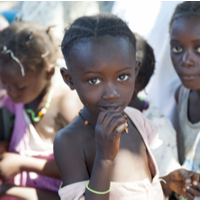
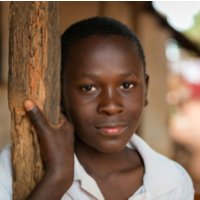
Children’s rights in Guinea-Bissau have been left in a precarious situation and their implementation hindered by political and military unrest, as well as instability which has further delayed the harmonization of national laws in line with international provisions. Children are at risk of early child marriage, child labour, child trafficking, gender inequality, corporal punishment, climate change and female genital mutilation.

Children’s Rights Index: 4,98 / 10
Black level: Very serious situation
Population: 1.9 million
Population aged 0-14: 41.9%
Life expectancy: 58 years
Under-5 mortality rate: 84 ‰
Guinea-Bissau at a glance
Guinea-Bissau, a former Portuguese colony, is a country situated on West Africa’s Atlantic coast. It is a tropical archipelago known as the Bijagós, which consists of more than 100 islands, more than 20 of which are inhabited. To the north, it shares a border with Senegal and to the south and east, it shares a border with Guinea. It is one of the poorest and most fragile countries in the world. The Gross Domestic Product (GDP) of Guinea-Bissau is one of the lowest in the world (World Bank, 2020).
Historically, Guinea-Bissau has been fraught with political coups and institutional instability which dates back to its fight to gain independence from Portuguese colonial rule. During the earlier segments of the 20th century, Guinea-Bissau was the victim of an exceptionally repressive and abusive colonial regime. The country finally gained independence and international recognition of statehood in 1973, following a lengthy armed struggle between an independence movement and the existing colonial powers (UNICEF, 2021).
Since gaining independence, there have been 4 coups and 16 attempted coups (World Bank, 2020). In December 2019, the latest Presidential elections followed political instability which led to a Supreme Court Economic Community of West African States (ECOWAS) and European Union decision appointing Umaro Sissoco Embalo as the President of the country (World Bank, 2020).
Since the early 2000s, the country has been rampant with drug and human traffickers. In 2006, international aid was needed to stop human traffickers operating on the country’s coastline. In 2011, the European Union (EU) cut short its mission to reforming security forces and its aid to Guinea-Bissau, stating that the country had no respect for governance and the rule of law. The coastline and port of Guinea-Bissau are still used as major transit points for Latin American drug smugglers (BBC Monitoring, 2020).
Status of children’s rights[1]
Guinea-Bissau has committed to several international instruments for the protection of children’s rights. In 1990, the government ratified the Convention on the Rights of the Child (CRC) and the African Charter on the Rights and Welfare of the Child. In 2010, Guinea-Bissau ratified the Optional Protocol on the sale of children, child prostitution and child pornography and in 2014 the Optional Protocol on the involvement of children in armed conflict. The adoption of the CRC and it’s Optional Protocols marked a pivotal point in the government’s realization of the need for an effective child protection system for the children of Guinea-Bissau (João & Handem, 2011).
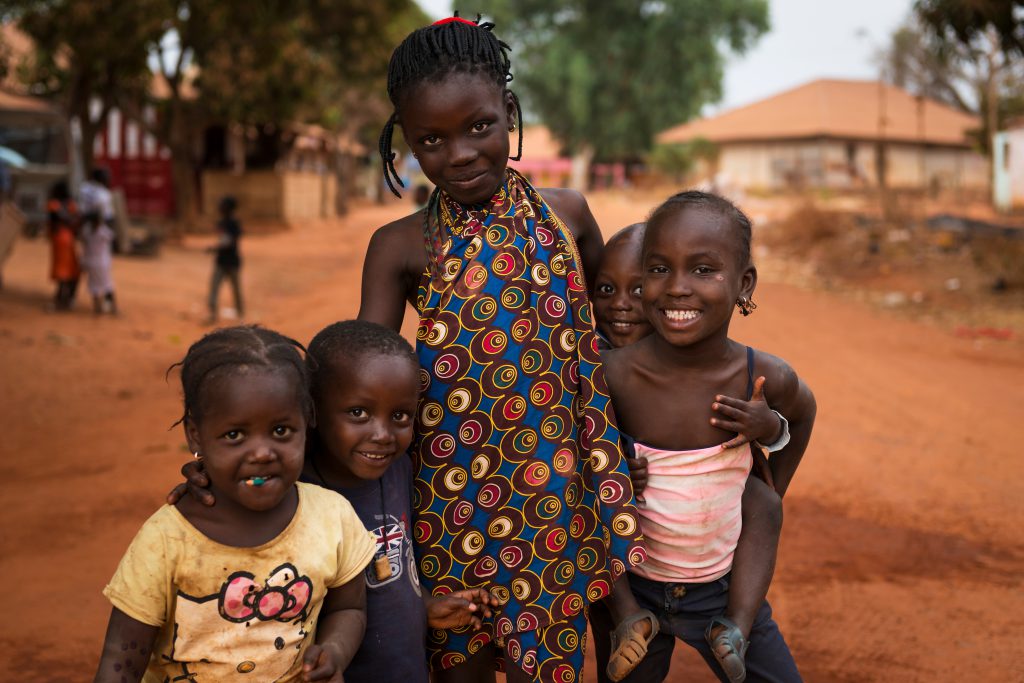
However, since the ratification of the CRC, the harmonization of national laws in line with the Convention remains slow and this delayed progress is attributed to the political and military instability, lack of political will, and political inability to prioritize and accelerate the harmonization of laws. Local and international non-governmental organizations (NGOs) have called for the inclusion of religious leaders and traditional chiefs at the early stages of these processes to ensure that religious and cultural norms do not encourage harmful practices (João & Handem, 2011).
Inclusive approaches to children’s rights are necessary to overcome poor educational levels and illiteracy across the country. Further, in the absence of an efficient judiciary system, there is a pressing need for bottom-up approaches to children’s rights (João & Handem, 2011).
Dissemination of the CRC in Guinea-Bissau has largely been undertaken by various children’s rights organizations including the Institute for Women and Children. This has largely been implemented through national awareness-raising campaigns conducted in communities and schools across various mediums including national radio, brochures, videos, dramas and lectures.
Despite these efforts, high illiteracy rates and competing traditional, cultural and religious motivations mean that the CRC’s recommendations are seldom realized (João & Handem, 2011). At a practical level, there is a further challenge related to the government’s approach whereby the CRC is distributed without the necessary accompanying sensitization and training on its contents (João & Handem, 2011).
Guinea-Bissau is yet to officially translate the CRC into the most widely spoken local languages, forcing institutions and organizations to undertake ad-hoc and makeshift translations as necessary and utilize the translated version from Portugal, where useful. National authorities have also failed to harmonize domestic legislation with the CRC and other international instruments, making it difficult to ensure the implementation of international standards and undermining awareness-raising initiatives.
Without an adequate framework for the legal assurance of children’s rights, the country is forced to rely on archaic colonial legislation which diminishes the importance of children and the challenges they face. As a result of these factors, the general population does not place much importance on children’s rights concerns, perceiving them as meaningless to their everyday lives (João & Handem, 2011).
Nationally, in 1990, the country created its first Children’s National Commission (CNC) following on from the Inter-Ministerial Child Protection Committee (ICPC) in 1987. Through this, the country participated in the high-level World Summit on Children that took place in New York. The aim of the summit was to discuss priorities and actions towards improving the global children’s rights situation by 2000.
The first National Action Plan for Children was drafted, adopted and implemented in 1992 (João & Handem, 2011). Since the implementation of the National Action Plan which was to cover a decade (1992-2002), no other national strategy or policy has been designed for children.
The country’s first initial state party report on the implementation of the CRC was meant to be submitted in 1997, but due to military and political conflict through to 1999 this process was interrupted and later submitted to the Committee on the Rights of the Child in 2000. Since the early 2000s, Guinea-Bissau has committed to and participated in several national, regional and international strategies and agreements to further children’s rights. These have included the National Birth Registration Campaign for Children in collaboration with UNICEF, the adoption of “A World Fit for Children” which addressed four priorities namely: promoting healthy lives; providing quality education; protecting children against abuse, exploitation and violence and lastly combating HIV/AIDS (João & Handem, 2011).
Legislatively, there are various provisions that provide for children. These include the Constitution of the Republic of Guinea-Bissau, Sector Court Law, Criminal Code and Statute of Minors’ Judicial Assistance. Despite the existence of legal provisions, enforcement of these provisions remains weak and are not in unison with international instruments that the country has signed and ratified. The children’s social protection system remains inadequate, more specifically regarding access to child protection systems as well as basic social services (João & Handem, 2011).
In Guinea-Bissau, juvenile justice remains a critical issue. Legislation and case management in the country is poorly implemented, the juvenile justice system is not in line with the Convention on the Rights of the Child (CRC) and other international human rights instruments such as the United Nations Standard Minimum Rules for the Administration of Juvenile Justice (Beijing Rules), the United Nations Guidelines for the Prevention of Juvenile Delinquency (Riyadh Guidelines) and the United Nations Rules for the Protection of Juveniles Deprived of their Liberty (Havana Rules) (UNICEF, 2021).
Addressing the needs of children in Guinea-Bissau
Right to education
In Guinea-Bissau, formal education is organized into three cycles: the first being grades 1-4, known as EB1, EB2 between grades 5-6 and the third cycle EB3 between grades 7-9. The first two cycles are considered to be the compulsory stages of primary education and the third is considered secondary school where families are required to pay tuition fees (UNICEF, 2021).
One of the biggest hindrances to attending school for children is physical accessibility. The average minimum commute for children is 2.2 kilometres (km) and this varies amongst the different regions and goes up to an average distance of 6km. In Bissau, the capital, children walk up to 3km to get to school, often having to carry their own stools or chairs (UNICEF, 2021).
For many children in Guinea-Bissau, access to quality education remains a challenge; the country has the lowest primary school completion rate in West Africa. The main barriers to education are: physical impediments, low enrolment rates, gender inequality and poverty. Outside of urban areas, the lack of accessibility to schools, especially for secondary school students, contributes to the low enrolment rates.
Access to education for children in Guinea-Bissau remains a challenge for reasons such as teacher strikes, child labour, early child marriage, insufficient funds for teaching materials and inadequate school facilities. Between 2016 and 2017, 46% of academic teaching days were lost to teacher strikes (Borgen Project, 2021).
In 2019, Guinea-Bissau had a 27.2% primary school completion rate. Early drop-out rates or late entry into education are the main causes of such low school completion rates. One-third of children in the country between the ages of 6 to 11 are considered “out-of-school children.” This means that these children have never attended school or have dropped out.
There are large inequities between urban and rural areas, out of the 27.2%, 10% of these children are from urban areas and 36% are from rural areas (UNICEF, 2021). Schools in Guinea-Bissau frequently lack training on inclusive education and equality of all students. This is seen in the experiences of children with disabilities and girls. For children with disabilities, the barriers to inclusive education include a lack of appropriate infrastructure and adequate staff and teacher training. For girls, schools often lack adequate sanitation facilities that have a greater impact on girls (UNICEF, 2021).
Right to health
In Guinea-Bissau, access to health care, food and clean drinking water remains precarious. Malaria, tuberculosis, cholera, malnutrition, infectious and respiratory diseases, diarrhoea and HIV/AIDS continue to be prevalent across the country, contributing to the high child mortality rate. Hospitals and medical centres are in a degraded state, most of which lack adequate equipment and have poor quality of health-related services.
Nationally, government budgets and corruption have impacted salaries which has further created inadequate working environments, leaving doctors, nurses and other medical practitioners unpaid (João & Handem, 2011). Given this, the health sector in Guinea-Bissau is heavily reliant on international aid, limiting the capacity of infrastructure health facilities and hospital equipment (João & Handem, 2011).
The infant mortality rate in Guinea-Bissau for children under the age of five is 84 per 1000 live births. This worrying statistic is emblematic of both the widespread shortage of adequate hospital and care facilities, as well as persistently high levels of malnutrition. In Guinea-Bissau, undernutrition is a public health challenge that is attributed to food insecurity.
Across the country, 78 nutritional rehabilitation centres (NRC) have been established but they have had very little success. The limiting factors include exhaustion from visits which negatively impact the willingness of parents to bring their children to the centres and the centres losing track of patients before finishing their treatment (UNICEF, 2021).
Across four different regions in Guinea-Bissau, NRCs tested for HIV-positive children and the numbers have risen between 2015 and2017. It is estimated that approximately 5.3% of the population between the ages of 15-49 are living with HIV/AIDS, making Guinea-Bissau the second-highest rate in West Africa (UNICEF, 2021).
Beyond inadequate funding, the country’s health system has limited access to necessary equipment and drugs, putting further strain on its overburdened workforce. According to recent UNICEF research in 2017, there were only 1.7 doctors per 10,000 people in Guinea-Bissau, that number drops further for paediatricians: 3 for every 720,000 children under the age of 15 (UNICEF, 2021).
Right to clean water and sanitation
The availability of clean, safe, potable water and sanitation facilities remains a challenge in Guinea-Bissau and there exists a huge discrepancy between urban and rural areas. In a 2014 UNICEF report, it was found that 50% of handpumps installed were either not functioning or had deficiencies that contributed to unsafe water sources.
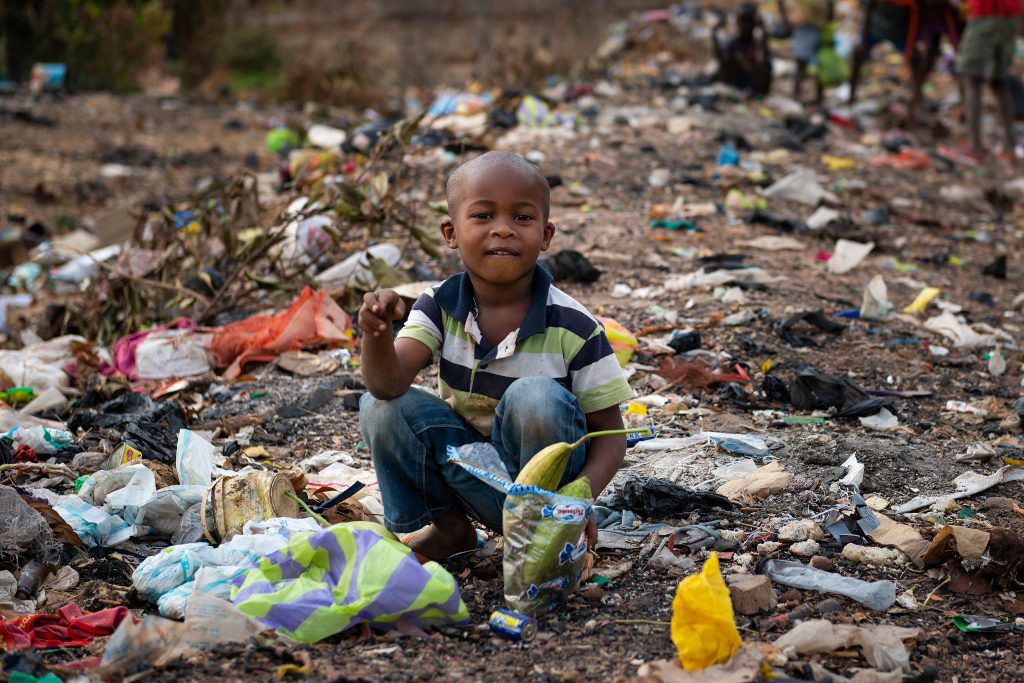
Moreover, 13% of Bissau-Guineans had used improved sanitation facilities, 27% of the urban population and 2% of the rural population shared sanitation facilities, while 1.7% of the urban population and 30.2% of the rural population practiced open defecation. As a result of this, children in Guinea-Bissau suffer from epidemics and poor health (UNIOGBIS-HRS/OHCHR, 2017). Access to a clean supply of drinking water and improved sanitation remains low in Guinea-Bissau, with very few children, 6 in 10, using water from improvised water wells and 3 in 10 children having access to adequate sanitation (João & Handem, 2011).
Right to identity
Under the 1967 Civil Code of Registry, birth registration is a legal requirement. Legally, the Civil Code allows for birth registrations up to 30 days after birth. In 2011, this rule was changed to allow registrations for free up until the age of 8 years old. After the age of 8, there is a penalty fee. There are various barriers to registration such as access, documentation and costs. Challenges are also created by the registration process which mandates the identification of a child’s parents.
In some instances, such as where children are born with abnormalities, parents are reluctant to accept responsibility and thus opt not to register their child at all. Since 2019, the birth registration rate for children under the age of 5 has increased to 46%. This is a drastic increase from the 24% of registered children between 2010 and 2014 (UNICEF, 2021).
Risk factors → Country-specific challenges
Child trafficking
Guinea-Bissau is a country that is heavily affected by child trafficking. Trafficking often takes place with talibé children who are sent to neighbouring West African countries that are believed to have a better religious education. Traditionally, families and communities believe that sending their children to Koranic schools is important. The talibé, Bissau-Guinean children who attend madrassas (Koranic) schools, are the most prone and vulnerable to trafficking, abuse and exploitation (Redazione, 2020).
A majority of Koranic schools serve as boarding schools and are predominant across the eastern region of Guinea-Bissau. These children work and live in precarious situations where they are forced to beg or conduct agricultural work. Many parents chose to send their children to similar schools in the neighbouring countries of Gambia or Senegal. As of 2018, there were approximately 120,000 talibé children living in Senegal.
These children are undocumented, living without birth certificates or official status which makes them vulnerable to exploitation, trafficking, abuse and statelessness (UNICEF, 2021). This phenomenon and practice is prevalent in the regions of Gabu and Bafata and is used a guise to force children into begging, child labour and sexual exploitation while receiving little food, often sleeping on the streets and wearing tattered clothing (Redazione, 2020).
Bissau-Guinean boys are frequently trafficked for use as child labourers in the agricultural and mining sectors of Senegal, especially from the southern cities of Kolda and Ziguinchor. These boys are forced to support cashew nut harvesting and begging schemes, as well as common street work such as shoe shining.
By contrast, traffickers exploit Bissau-Guinean girls for the purposes of forced child labour in street vendors and domestic work. Girls are utilised in Guinea, Gambia, Senegal and even trafficked to Spain as child labourers. Beyond child labour, girls are widely exploited in sex trafficking schemes, being forces towards modelling jobs and sex work in bars, nightclubs and hotels in and outside of the country.
In particular, both girls and boys are exploited in child sex tourism in the Bijagos, an archipelago along the coastline which lacks proper enforcement capabilities (US Department of State, 2021). In response to these challenges, in February 2019 the government amended the Code of Child Protection hoping to harmonize it with international law, but is yet to officially adopt the amendment (US Department of State, 2021).
Child labour
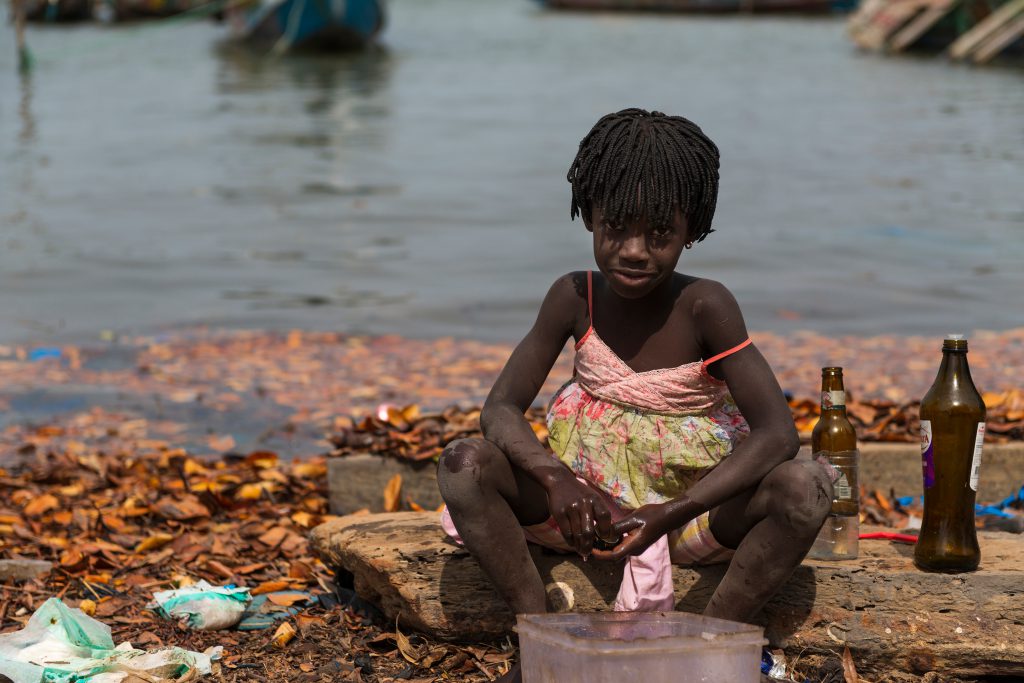
Child labour is deeply rooted and ingrained in Bissau-Guinean society, where children must take on the responsibility of providing food security for their families. At different ages, children are expected to take on certain tasks which are culturally seen as social education. It is believed that through different roles, children learn about the environment, how to look after their land and livestock and learn to protect natural resources. Through this, children continue the profession of their predecessors in accordance with community rules (João & Handem, 2011).
Under the General Labour Law children over 14 years of age are permitted to engage in paid work provided that it does not interfere with their academics. Accordingly, children are not meant to work at night. Notwithstanding these provisions, children across the country frequently engage in work to support household economies and alleviate the financial burden from their parents.
Felupe girls, for example, typically take on domestic work from an early age. Similarly, Papel boys in their early teens are common within weavers’ shops in Senegal and Gambia. Family members often facilitate and encourage child labour, finding workplaces for their children to generate greater household income (UNICEF, 2021).
Generally, there are notable differences in the experiences of girls and boys in child labour. Girls are more likely to work longer hours and support domestic activities. Boys are more likely to be subjected to manual labour – talibé boys, in particular, are widely used in agriculture, repair work, sawmills and carpentries.
Child abuse
The use of physical violence and corporal punishment is widespread within schools in Guinea-Bissau. Violence against children is prevalent against children in the Animist community known as the Irá (Iran) children. It is believed that these children are the reincarnation of bad spirits and witchcraft and for that they are ostracised and demonised by the community.
Often, these children are twins, children with disabilities, children who are born albino or children who have psychological problems and are subjected to violence and in extreme cases infanticide (UNICEF, 2021). Currently, there are no government funded shelters that provide support to children who are victims of violence. The assistance that is available is provided by NGOs, community-based groups and religious organizations (UNICEF, 2021).
Gender inequality and discrimination
Guinea-Bissau has a deeply patriarchal society which creates a gender bias in accessing resources. Young women and girls are directly affected by the dominant male roles within society, making them more vulnerable and prone to poverty, early child marriage, female genital mutilation (FGM) and early school dropout (UNICEF, 2021).
Children with disabilities remain amongst the most disadvantaged in Guinea-Bissau. Their needs are not taken into account in a family, educational, social and health setting. Families living in poverty are unable to financially meet the special needs children with disabilities have which further exacerbates their poor health and living conditions. Due to political instability, very few children with disabilities benefit from social assistance and protection. Voluntary infanticide for children with disabilities remains high and law enforcement remains weak which further perpetuates this evil practice (João & Handem, 2011).
Child marriage
Child marriage is prevalent in Guinea-Bissau. A large discrepancy between national and international laws exists regarding child marriage. This is further complicated by the fact that Guinea-Bissau follows a mixed legal system that includes customary law (UNICEF, 2021).
The 2007 Civil Code in Guinea-Bissau does not permit children under the age of 16 years old to marry without parental consent. Nationally, there are no policies that prevent or address child marriage. Since 2011, child protection stakeholders have attempted to implement preventative measures in order to address child marriage and raise the minimum age of consent to 18 years old.
Legally, with the consent of both parents, 16- and 17-year-olds can marry (UNICEF, 2021). This law contradicts the Maputo Protocol, which sets the minimum age for marriage at 18. Nationally, under the Domestic Violence law of 2013, it is punishable for up to 4 years if a parent forces a child into marriage.
Female genital mutilation
Across rural areas in Guinea-Bissau, harmful cultural practices that affect both boys and girls are prevalent. For girls, the practice of female genital mutilation (FGM) is viewed by traditional and religious leaders as a normal practice that preserves and makes women honourable for marriage. To date, over 400,000 women and girls have undergone FGM. 52% of them are women and girls between the ages of 15-49, predominantly from the Gabu region (where 96% of women experience FGM) and in the Biombo region (8%) (UNICEF, 2021). Since 2011, the establishment of the Federal Law No. 14/2011 outlines all forms of FGM (28 Too Many, 2021).
Environmental challenges
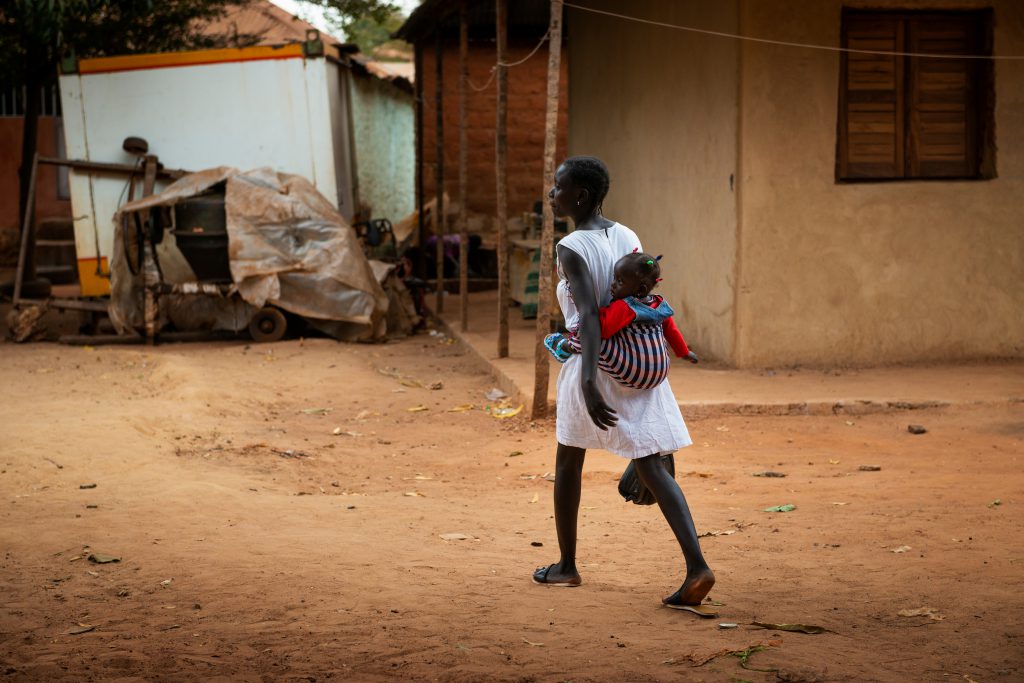
According to a recent comprehensive analysis of the impact of climate change and children’s rights carried out by UNICEF, within the Children’s Climate Risk Index (CCRI), Guinea-Bissau is ranked as the fourth highest African country where climate change is putting children at risk. Guinea-Bissau has a ranking of 6.4 for climate and environmental factors and 9.5 for child vulnerability. The CCRI is categorized according to two pillars, firstly the children’s exposure to climate and environmental causes and secondly, children’s vulnerability (UNICEF, 2021).
Due to its geographical location along the coastline, floods, drought and heavy rainfall are a recurring hazard. During the heavy rains, the sea levels rise which impact and affect 70% of the coastal regions of Guinea-Bissau. As a result of drought, there has been an increase in meningitis and other epidemics and infections and flooding increases the risk of waterborne diseases (World Bank, 2021).
Written by Vanessa Cezarita Cordeiro
Last updated on 9 September 2021
References:
28 Too Many. (2021). ¨Guinea-Bissau FGM prevalence.¨
BBC Monitoring. (2020, March 2). “Guinea-Bissau country profile.”
Borgen Project. (2021, January 4). “Challenges in education in Guinea-Bissau.”
Human Rights Watch. (2010, July 20). ¨Guinea-Bissau: pass anti-trafficking law.”
IOM. (2018, March). “Guinea-Bissau.”
Mendes, L. (2020, August 27). ¨Child marriage kills dreams in Guinea-Bissau.¨
UNICEF. (2021, August). ¨The climate crisis is a child rights crisis.¨
UNICEF. (2021, March). ¨Female genital-mutilation in Guinea-Bissau.”
UNIOGBIS-HRS-OHCHR. (2017, April). “Report on the Right to Health in Guinea-Bissau.”
US Department of State. (2021). “2021 trafficking in persons report: Guinea-Bissau.” Office to monitor and combat trafficking in persons.
World Bank. (2020, July 15). “The World Bank in Guinea-Bissau.”
World Bank. (2021). ¨Guinea-Bissau.¨ Climate change knowledge portal.
[1] This article by no means purports to give a full or representative account of children’s rights in Guinea-Bissau; indeed, one of many challenges is the scant updated information on the children in Guinea-Bissau, much of which is unreliable, not representative, outdated or simply non-existent.

